It has been 41 days since Akasa Air, the new airline launched by ex-Jet Airways management Vinay Dube, Praveen Iyer, Belson Coutinho and bankrolled by the late investor Rakesh Jhunjhunwala, with Aditya Ghosh, ex-IndiGo president taking on the co-founder title and supporting the airline on his behalf. The airline launched operations on August 7, 2022, with a Mumbai – Ahmedabad flight being its first flight. I could not make it to the flight, but I flew with them on their second flight, the Ahmedabad – Mumbai flight.
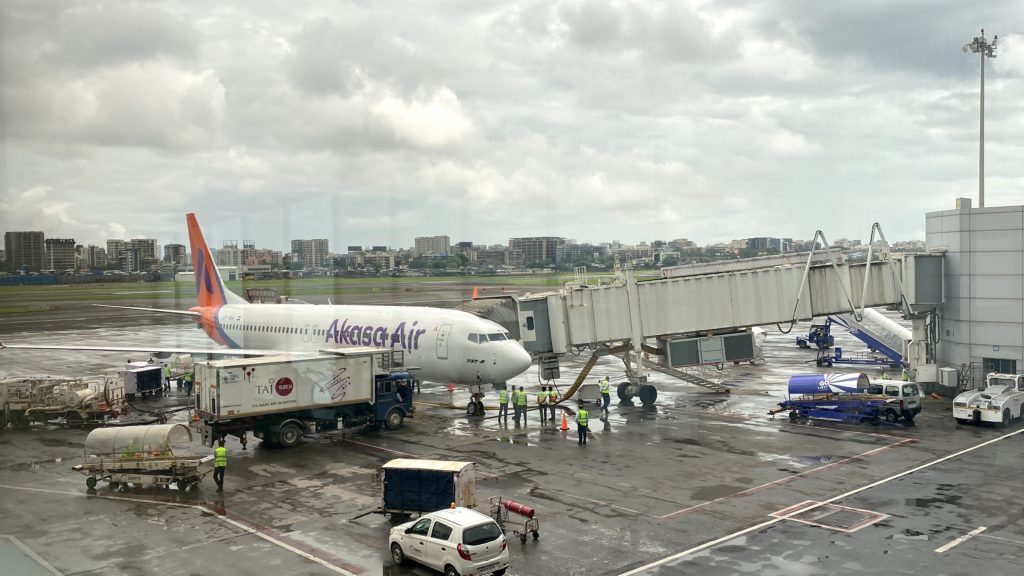
The airline is growing at a fantastic pace, not seen recently amongst many other airlines, for instance, AirAsia India, which grew in fits and starts and took a long time to reach even their first 20 aircraft. Akasa Air, on the other hand, has a strategy where they are going to take a quick ramp up and head for being a serious competition within the first year of operation itself.
Akasa inducts four aircraft into the fleet within 40 days of launch, the fifth on its way.
Akasa announced their 72 Boeing 737-8 aircraft order at the Dubai Airshow 2021. It was a happy coincidence and a meeting of various circumstances. India is predominantly an Airbus-dominated market when it comes to narrow-body aircraft, with IndiGo, Go First, Vistara, Air India and AirAsia India all being Airbus A320/neo customers.
On the other hand, Boeing was big with Jet Airways, grounded in 2019 and preparing for a relaunch. Their other customers include SpiceJet, which announced a big Boeing 737 MAX order. However, after the grounding of the MAX was lifted, it never came up to pick up its aircraft; hence, many of these were remarketed to Southwest Airlines in the US. Things are so dire with SpiceJet that even with the 13 aircraft that were inducted pre-grounding, two, VT-MXD and VT-MXF, are grounded, with the airline making noises about inductions of new aircraft. Still, when the choice is to save the airline for another day and induct new aircraft, you know the choices that will be made. Air India Express, which is currently absorbed into the Tata Group, has no order to make as well. They are instead taking over the leases of 737-800 aircraft earlier inducted into sister airline Vistara.
Akasa came into the picture as the best suitor. Boeing had a stockpile of already manufactured aircraft to deliver, which were cancelled by other airlines due to the extended grounding of the 737 MAX. Akasa had the pedigree, both management and money-wise, to absorb these aircraft. The first eighteen aircraft are planned to be inducted into the fleet by the end of fiscal 2023 (March 2023), with a new aircraft coming into the fleet every fortnight. These are all aircraft that are essentially not taken up by other airlines and perhaps offered to Akasa and other suitors at bargain prices. After this, the airline moves to a denser configuration, 737-8-200, which will be custom-assembled for Akasa.
The first four aircraft inducted into the fleet have all been under a sale and leaseback arrangement with Griffin Global Asset Management. These aircraft were initially assembled for T’Way Air, a South Korean low-cost carrier, which had ordered eight of these aircraft in 2017, and these were to be inducted into the fleet between mid-2019 and 2020.
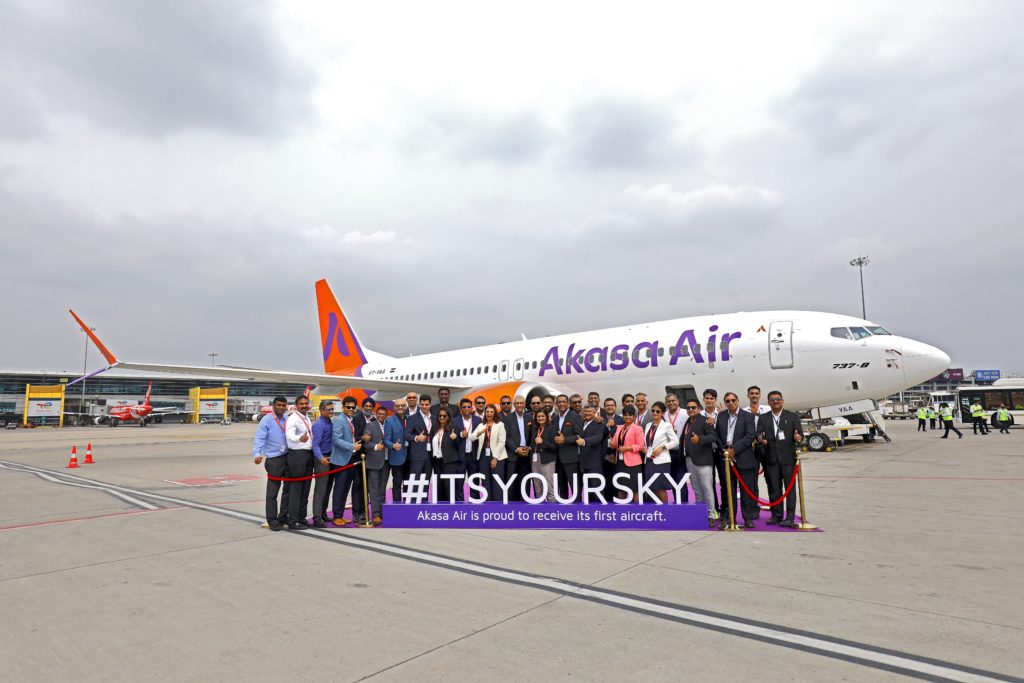
Here is how the induction has gone so far:
- VT-YAA: Delivered on June 16, 2022 (at Boeing Delivery Centre, USA)
- VT-YAB: Delivered on July 26, 2022 (at Delhi, India)
- VT-YAC: Delivered on August 15, 2022 (at Delhi, India)
- VT-YAE: Delivered on September 3, 2022 (at Delhi, India)
- VT-YAD: Yet to be delivered, expected within September 2022
Akasa’s initial route network
While Akasa had initially indicated that it would like to create a differentiated network heading into Tier 2 and Tier 3 airports around India, what we see in the first forty days is more like metro airports being covered. However, they are in line with the Route Disbursal Guidelines for now. Here is the route network of the airline that has been announced so far:
| Flight # | From | Departure | To | Arrival |
| Commenced August 07, 2022 | ||||
| QP 1101* | Mumbai | 10:05 | Ahmedabad | 11:25 |
| QP 1102* | Ahmedabad | 12:05 | Mumbai | 13:25 |
| QP 1107 | Mumbai | 14:05 | Ahmedabad | 15:25 |
| QP 1108 | Ahmedabad | 16:05 | Mumbai | 17:15 |
| Commenced August 12, 2022 | ||||
| QP 1353 | Bengaluru | 11:00 | Kochi | 12:30 |
| QP 1354 | Kochi | 13:10 | Bengaluru | 14:15 |
| Commenced August 13, 2022 | ||||
| QP 1351 | Bengaluru | 7:15 | Kochi | 8:30 |
| QP 1352 | Kochi | 9:05 | Bengaluru | 10:25 |
| Commenced August 19, 2022 | ||||
| QP 1104 | Bengaluru | 11:40 | Mumbai | 13:15 |
| QP 1105 | Mumbai | 13:55 | Bengaluru | 15:40 |
| QP 1106 | Bengaluru | 16:20 | Mumbai | 18:00 |
| QP 1306 | Mumbai | 18:40 | Bengaluru | 20:15 |
| Commenced August 23, 2022 | ||||
| QP 1314 | Bengaluru | 14:55 | Ahmedabad | 17:15 |
| QP 1315 | Ahmedabad | 17:50 | Bengaluru | 19:50 |
| Commenced August 30, 2022 | ||||
| QP 1109 | Bengaluru | 6:55 | Mumbai | 8:35 |
| QP 1110 | Mumbai | 9:15 | Bengaluru | 11:00 |
| Commenced September 10, 2022 | ||||
| QP 1319 | Bengaluru | 8:30 | Chennai | 9:35 |
| QP 1320 | Chennai | 10:15 | Bengaluru | 11:20 |
| QP 1313 | Bengaluru | 12:00 | Chennai | 13:05 |
| QP 1316 | Chennai | 13:40 | Bengaluru | 14:35 |
| Commenced September 15, 2022 | ||||
| QP 1304 | Mumbai | 18:10 | Chennai | 19:55 |
| QP 1305 | Chennai | 20:50 | Mumbai | 22:45 |
| Commences September 19, 2022 | ||||
| QP 1301 | Bengaluru | 20:30 | Mumbai | 22:10 |
| QP 1103 | Mumbai | 23:25 | Bengaluru | 01:00+1 |
| Commences September 26, 2022 | ||||
| QP 1307 | Bengaluru | 15:15 | Chennai | 16:20 |
| QP 1310 | Chennai | 21:15 | Bengaluru | 22:15 |
| QP 1308 | Chennai | 17:00 | Kochi | 18:30 |
| QP 1309 | Kochi | 19:15 | Chennai | 20:40 |
| Commences October 03, 2022 | ||||
| QP 1113 | Mumbai | 6:05 | Ahmedabad | 7:25 |
| QP 1114 | Ahmedabad | 8:15 | Mumbai | 9:30 |
| Commences October 07, 2022 | ||||
| QP 1335 | Delhi | 11:40 | Bengaluru | 14:25 |
| QP 1336 | Bengaluru | 15:45 | Delhi | 18:30 |
| QP 1334 | Delhi | 19:20 | Ahmedabad | 20:55 |
| QP 1332 | Ahmedabad | 21:55 | Bengaluru | 00:10+1 |
| Commences October 08, 2022 | ||||
| QP 1331 | Bengaluru | 6:20 | Ahmedabad | 8:35 |
| QP 1333 | Ahmedabad | 9:10 | Delhi | 10:55 |
| +1 indicates NEXT DAY arrival | ||||
| All flights are daily, non-stop | ||||
| * Daily except for Wednesday | ||||
And here is a map of the route network, with the red lines indicating routes already launched and the blue lines indicating routes which will be launched in the next twenty days.
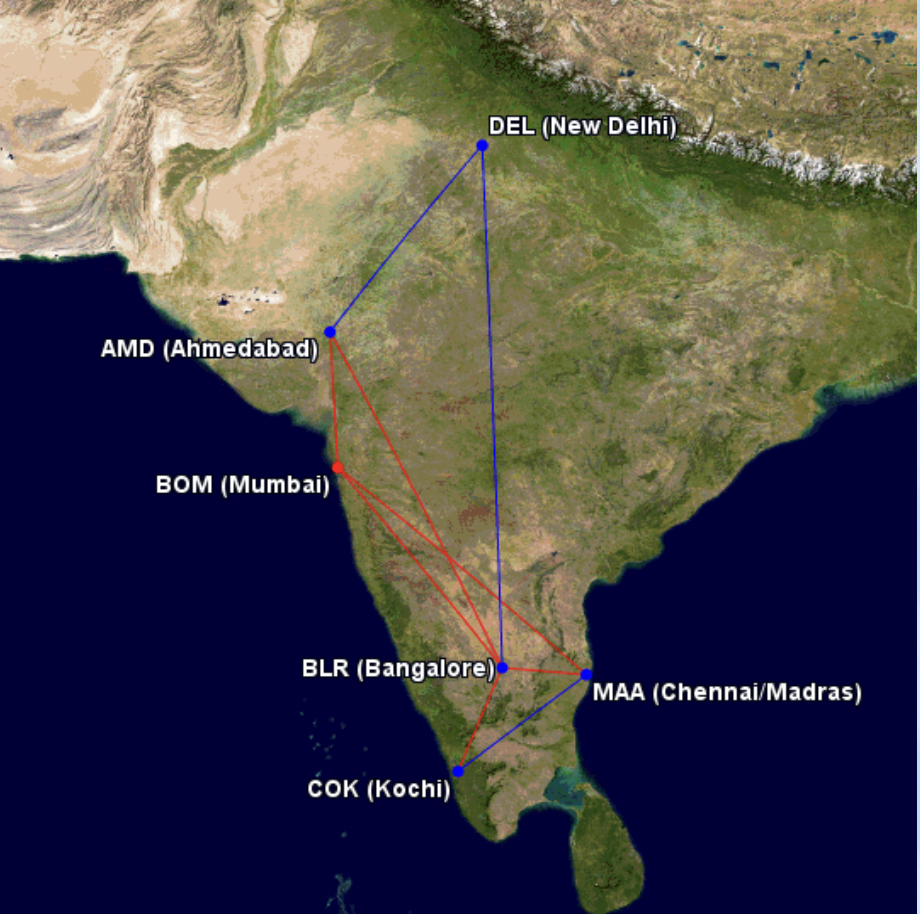
Akasa Air Route Map as of September 17, 2022 (courtesy GCMap.com)
Going by the Route Dispersal Guidelines, the current network of the airline is shaping up as follows:
- Category I:
- Delhi – Bangalore
- Mumbai – Chennai
- Bangalore – Mumbai
- Ahmedabad – Delhi
- Category III:
- Mumbai – Ahmedabad
- Chennai – Kochi
- Kochi – Bengaluru
- Bengaluru – Chennai
Anyone who operates scheduled air transport services on one or more of the routes under Category-I shall be required to provide services in Categories -II, IIA and III as per the DGCA norms.
- The operator will deploy at least 10% in Category-II of the capacity deployed on the Category-I routes, which indicates a service that connects to a station in the North Eastern Region, Jammu and Kashmir, Himachal Pradesh, Uttarakhand, Andaman & Nicobar and Lakshadweep.
- The operator will deploy at least 10% in category-IIA of the capacity deployed on Category-II routes, which indicates services amongst the North Eastern Region, Jammu and Kashmir, Himachal Pradesh, Uttarakhand, Andaman & Nicobar and Lakshadweep.
- The operator will deploy at least 35% in category-III routes of the capacity deployed on Category-I routes.
Note that while Akasa has time to align with these guidelines, if they want to run a well-balanced operation, you might start to see flights to J&K, Uttarakhand or the North East sooner than later. For the month of August 2022, Akasa operated only on Category I routes.
Akasa’s product offering
Akasa has a 189-seater aircraft in service at the moment, and all the aircraft entering service so far are fitted with Recaro BL3530 seats, with excellent padding and even headrests. That is unique for a no-frills carrier and makes for a comfortable ride. Air India’s A320neos use the same seats but with thinner padding.
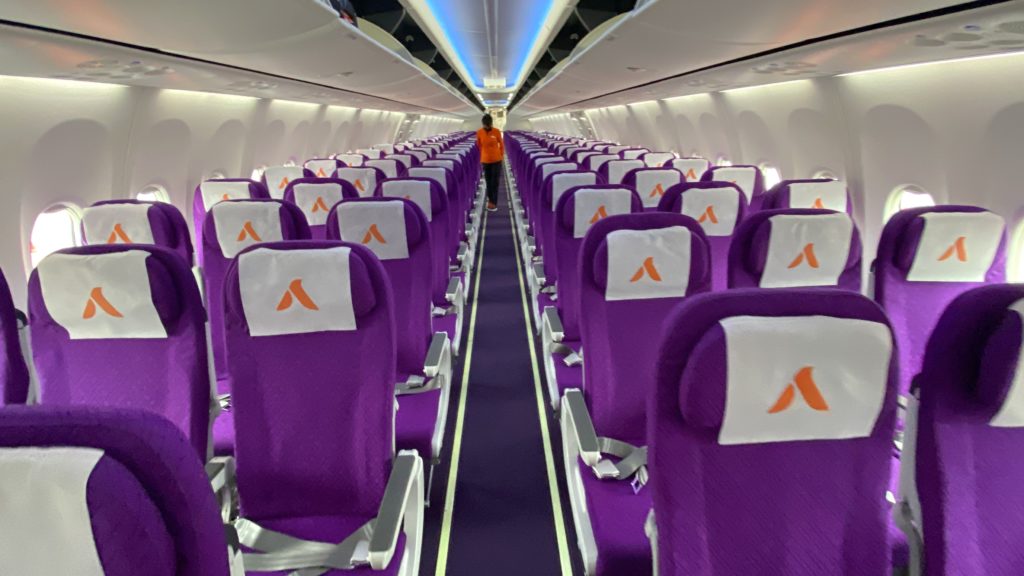
Also unique is the onboard USB-A charging, which has been provided on all seats and is a generous offering for an LCC. However, without any streaming IFE on board or seatback holders for the phones/tablets, this is good to have, but one cannot use this for anything beyond the use case of actually charging your equipment.
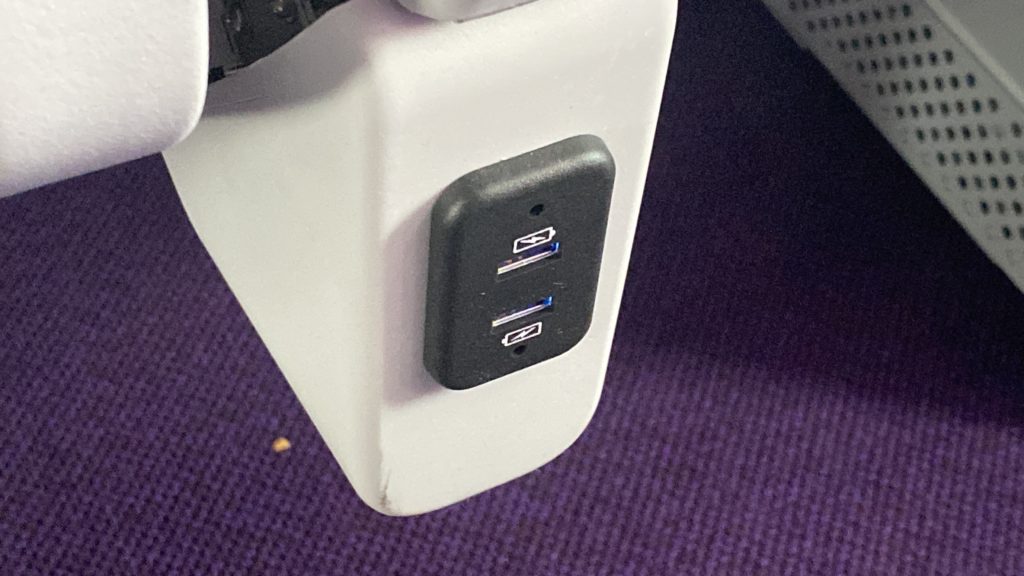
What Akasa needs to get right, however, is its digital experience. Of course, they followed the strategy of launching first and figuring out the digital experience along the way, but that has led to a clunky experience online. For instance, there are no free seat selections until you get to the airport (a la IndiGo which will assign you leftover seats if you don’t want to pay for preferred seats). If you choose to skip selecting add-ons for your ticket at the time of booking, you will be unable to add them on later online and will have to reach out to the contact centre or their SM team to get it fixed. These things will eventually be fixed but are not there in the initial days. There are other kinks to iron out as well, such as GST invoicing, which is bonkers right now and is a requirement for all sorts of businesses for the time being.
Traffic Carried
Akasa made a reasonably okay debut, one that the airlines’ top management was prepared for. In the first month of operations, which was actually just three weeks of operation, Akasa got a 52.9% load factor, meaning, on average, you would see about 95 passengers on each of their flights. For comparison, other carriers did the mid-70s to mid-80s in terms of load factors. Akasa carried 24000 passengers through the three weeks of operation and got a 0.2% market share as computed by regulator DGCA.
Bottomline
Akasa seems to be growing quickly and following a strategy of mass impact rather than profitable growth in the initial days. Ticket prices being offered by the airline on some segments are cheap (BOM-AMD going for INR 900 or so), and the airline wants to establish both network and frequency quickly in the Indian skies. You might even see them flying International in 2023/24 itself once they get their 20th aircraft in. While many of their plans will unfold in the coming months and years, what remains to be seen for me, is the differentiated network they hinted at and what will be the product on the 737-8-200.
Where do you think Akasa is headed from here? What airports and what routes will come up for them in your reading?
Liked our articles and our efforts? Please pay an amount you are comfortable with; an amount you believe is the fair price for the content you have consumed. Please enter an amount in the box below and click on the button to pay; you can use Netbanking, Debit/Credit Cards, UPI, QR codes, or any Wallet to pay. Every contribution helps cover the cost of the content generated for your benefit.
(Important: to receive confirmation and details of your transaction, please enter a valid email address in the pop-up form that will appear after you click the ‘Pay Now’ button. For international transactions, use Paypal to process the transaction.)
We are not putting our articles behind any paywall where you are asked to pay before you read an article. We are asking you to pay after you have read the article if you are satisfied with the quality and our efforts.


Leave a Reply